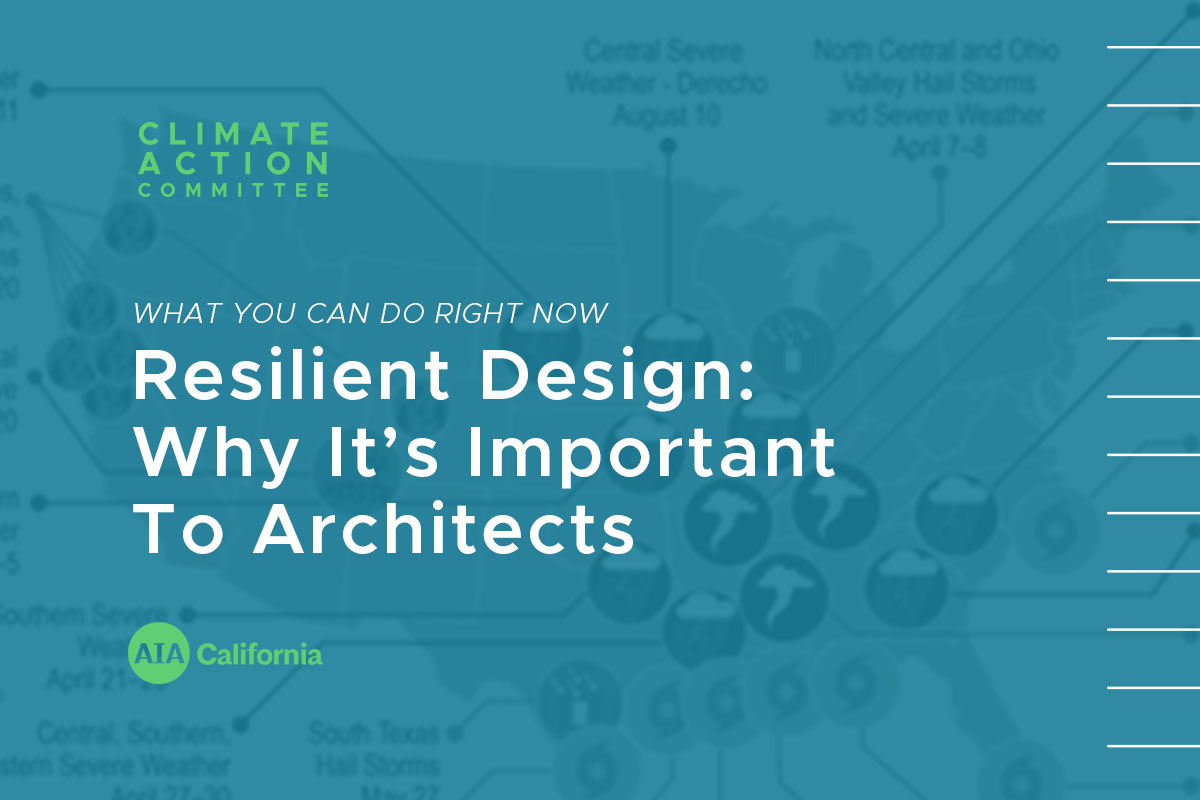
What is Resilient Design?
The AIA CA Resilience Design Committee has developed the following definition to guide it efforts:
Resilient Design is planning and designing our built environment to sustain probable impact from progressive climate change and episodic natural disasters.
What are the impacts of progressive climate change and natural disasters?
The cost of weather or climate related disasters is very high. The National Oceanic and Atmospheric Administration (NOAA) map below shows the disaster events, costing over a billion dollars each, that occurred in the United States in 2020 alone.

(1)
In California alone we have had 336 declared disasters between 1953 and 2020. (2)

(2)
In California’s major urban areas, such as Los Angeles and San Francisco, approximately 90% of building stock was built prior to modern building codes, making them more vulnerable to earthquake and other disasters. Unfortunately, only about 20% of building stock in those same areas have earthquake insurance.
A disaster’s impact on local economies and ecosystems can be very dramatic and long lasting. After Hurricanes Katrina & Rita hit New Orleans Louisiana, large numbers of people left the area, and many did not come back. The area is still trying to recover after 15 years.
After the devastating earthquakes, in Christ Church New Zealand, in 2010 & 2011, 70% of buildings needed to be demolished. The waste generated by this demolition created a huge environmental impact. (3)
According to a study conducted by FEMA. 40-60% percent of businesses do not reopen after a disaster and another 25% fail within one year. (4)
The number of electricity outages has doubled in the US over the last decade. (5) This is particularly concerning as electricity is required for both dual fuel buildings and electric-only buildings. Battery backup or other energy storage system should become an important part of a resilient future for projects in California.
What are the benefits of Resilient Design?
The benefits of Resilient Design risk reduction can be economic, such as reduced insurance premiums or maintenance costs, and can also include intangible benefits such as personal safety, business continuity, peace of mind, and the protection of irreplaceable personal belongings.
While designing buildings to meet Building Code requirements will provide a governmentally acceptable level of disaster mitigation, the National Institute of Building Science (NIBS) has shown that additional mitigation, above code requirements, can result in significant safety and financial rewards. The NIBS study shows that building to standards above Building Code can result in savings of up to $11 for every $1 spent on mitigation measures. (6)

Resilient Design and Building Codes?
Building Codes focus on occupant safety and egress. Continued use or cost of repair is not considered. Simple design decisions like building at a higher floor height than Code requirements in flood prone areas can return tremendous results. Building new buildings to be stronger and stiffer than required by the Code can minimize earthquake damage. Use of fire resistive building components can have a tremendous effect on structure survivability.
What are the Costs?
Resilient design cost varies dramatically based upon the types of disasters anticipated and the level of resilience required. Recent reports estimate that an average above code design representing an additional investment of approximately 2% over current building code requirements can reap a substantial payback in a disaster situation. (6)
Some costs can be offset by Government or Utility company programs such as California Earthquake Authority’s Brace + Bolt grant and insurance discount program. (7)
 What is the AIA’s Commitment?
What is the AIA’s Commitment?
The AIA, along with the National Institute of Building Sciences, has gathered a group of design and construction industry organizations representing over 1.7 million professionals to issue a joint statement on resilience. Each organization commits to research, educate, advocate, respond and to plan for a resilient future. The joint statement can be found at: Resilience_Industry_Statement_201026.pdf (aia.org)
Where to start?
Download and become familiar with the specific County or City Hazard Mitigation Plan and County or City Climate Adaptation Plan for your project area. Learn more about the potential disasters that could affect your project location and consider design changes that can mitigate negative effects.
Things you can do right now.
Resources
USGBC, RELi rating system:
https://www.usgbc.org/resources/reli-20-rating-guidelines-resilient-design-and-construction
US Resiliency Council: https://www.usrc.org/
EERI, Earthquake Engineers Research Institute: https://www.eeri.org/
American Institute of Architects (AIA)
Understanding resilience – AIA
Hazard mitigation design resources – AIA
Climate change adaptation design resources – AIA
How to integrate resilience into your practice – AIA
AIA Architect’s Guide to Business Continuity https://www.aia.org/resources/6282340-architects-guide-to-business-continuity
Citations/References